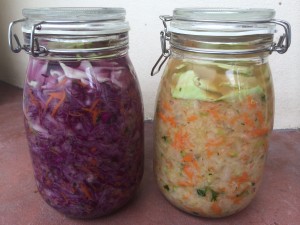Learning to make sauerkraut – thank you to Joanna from naturimedica.com
A number of years ago I attended a lecture by Sally Fallon who is the co-author of Nourishing Traditions. She spent a lot of time talking about the health benefits of fermented foods and her talk was very inspiring. At the time, however, I was working full-time and studying part-time and I didn’t have the headspace or time to start making my own fermented food. Many years down the track, the energies have aligned and I am ready to embark on my fermenting journey. I began with water kefir – here is my blog post about it My Latest Passion/Obsession – Water Kefir.
Yesterday I began my first batch of sauerkraut. I have a wonderful friend and colleague Joanna Sochan who is a Naturopath, Nutritionist and Herbalist (she practices in the Sydney CBD and in Thornleigh). She grew up in Poland and in her youth she enjoyed making sauerkraut with her Dad. I used her delicious recipe for my first attempt at making sauerkraut. I am so grateful that I was able to call her as I was making my sauerkraut for real-time tips. Here is Joanna’s sauerkraut blogpost and recipe.
JOANNA’S SAUERKRAUT RECIPE – Copyright Naturimedica.com
Ingredients (for about two 1 litre jars or one bigger one) – all organic vegetables are best
- 2 medium cabbage heads with the cores removed and finely shredded (the finer the better as more juice will be released faster). Reserve 3-4 large outer leaves to cover the sauerkraut once it’s in the jars
- 2-3 tablespoons of Celtic salt/sea salt
- 1-2 carrots finely shredded
- 1 onion finely shredded
- 5 whole peppercorns
- 2 tsp all spice (1 for each jar)
- 2 small bay leaves (1 for each jar)
- 1 tsp of caraway seeds (optional)
Steps:
- Start shredding/chopping the cabbage and transfer it to a large ceramic or glass bowl and sprinkle with the sea salt (transfer after you shred about half a cabbage, and repeat the procedure). The salt helps to pull the water from the cabbage, which creates the brine in which the sauerkraut will ferment.
- Add all other ingredients and mix well. Then start to knead the mix (best with your hands), until the volume decreases by half and the cabbage releases its juice. It may take 10-15 minutes to get the right consistency i.e. when the cabbage is just covered with the liquid. If after the thorough kneading there is not enough juice, you can add some water to the mixture.
- When kneading is done, tightly pack the cabbage into the sterilised jar(s) eliminating any air bubbles and making sure the cabbage is submerged in its juice at all times. Wait for the jars to cool before putting the sauerkraut in (so that you don’t damage any of the heat sensitive nutrients).
- When the jar is about 90% full, cover it with one outer cabbage leaf cut into pieces (as required), make sure the leaves are also submerged in the juice. Then put some weight on top (such as a rock found on the beach or a cup with rice) to keep the contents submerged during the fermentation. Important: if the cabbage is exposed to air, it will rot instead fermenting.
- Cover the jars with plastic wrap with a few holes poked in it to let out the gases. Place the jar into a container (to catch any juice that bubbles over as the ingredients ferment). Joanna warned me that the sauerkraut will smell as it is fermenting (she leaves it in her garage).
- Leave the sauerkraut at room temperature for around 7-10 days during warm weather (longer in colder conditions). Taste the cabbage after 5-7 days to see if it’s ready – it should be crunchy, tangy and mouth-watering. Once the sauerkraut taste the way you like it, remove the stone and the outer cabbage leaves and any scum that may develop as a part of the process (this is normal). Discard any parts of the leaves / sauerkraut that have any traces of the scum or any discoloured cabbage (usually the top layer). Trust your nose – if it smells and tastes OK, it most likely is.
Keep in the fridge to slow down the fermenting process, especially in the warm weather. It should keep for 2-3 months or longer but it never lasts that long in my place:).
Once you make the ‘basic’ sauerkraut you can start to create your own tasty blends adding other vegetables and herbs such as chilli, beetroot, radish, ginger, garlic, dill and parsley or seaweed (wakame, kelp or dulse) to make it extra rich in minerals. If you add half a red cabbage to the mix you’ll get a great looking and tasting pink mix. In fact you can make sauerkraut in many colours – add more carrots to make it orange or herbs to create an emerald green blend.
Here is Joanna’s blog post about fermented vegetables and beet kvass (including recipes). They are both probiotic rich additions to your diet (that are easy to make and fantastic for digestive and immune health).
Thank you Joanna.
Enjoy, Best wishes
Helene
www.evolvingmamma.com
www.lightchiro.com.au



1 Comment
Looks great Helene! Thanks for posting this:)